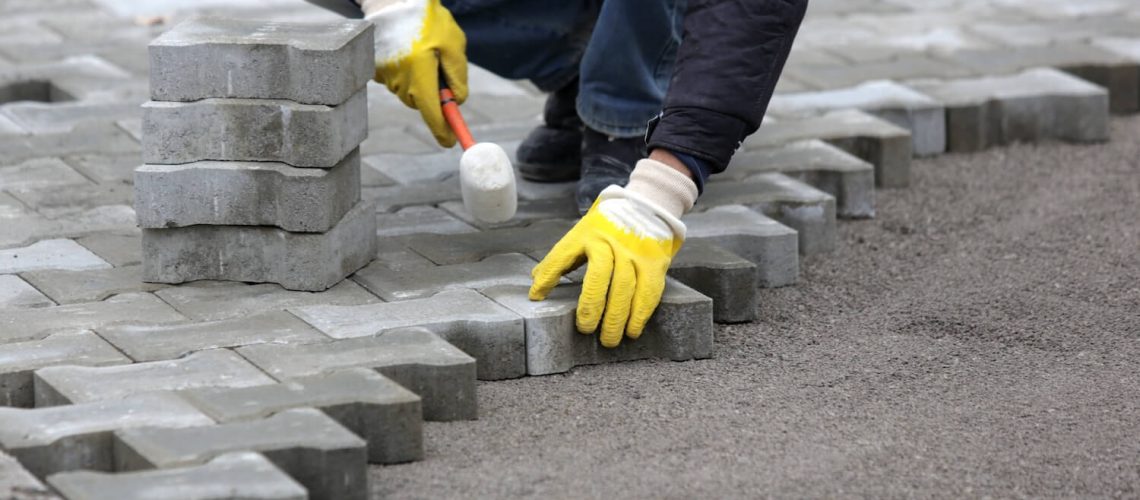In the world of real estate, first impressions matter significantly. The exterior of a property often serves as a preview of what’s inside, influencing potential buyers, tenants, or clients before they even step through the door. This is particularly true for commercial properties, where the stakes are high, and the need to attract and retain clientele is paramount. One of the most effective ways to enhance the curb appeal and overall value of a commercial property is through professional hardscaping.
Hardscaping refers to the non-living elements of landscaping—think walkways, patios, retaining walls, and other built structures. Unlike softscaping, which involves plants, trees, and flowers, hardscaping provides the framework for the landscape and contributes to the property’s functionality, aesthetics, and value.
In this article, we will explore how professional commercial hardscaping can significantly boost property value, the benefits it offers, and key considerations for implementation.
The Benefits of Professional Commercial Hardscaping
Enhanced Curb Appeal with Landscaping
One of the most immediate and noticeable benefits of professional hardscaping is enhanced curb appeal. A well-designed hardscape creates a polished, professional look that can attract customers, clients, and tenants. Clean lines, well-placed walkways, and attractive features such as fountains or statues make a property more inviting and memorable.
Increased Property Value
Investing in professional hardscaping can yield a high return on investment. According to real estate experts, properties with well-executed hardscaping can see an increase in value by up to 15%. This is because hardscaping improves the overall aesthetics and usability of the outdoor space, making the property more appealing to potential buyers.
Low Maintenance Hardscaping
Unlike softscaping, which requires regular watering, pruning, and fertilizing, hardscaping elements are generally low maintenance. Materials like stone, concrete, and pavers are durable and can withstand harsh weather conditions, reducing the need for frequent upkeep. This is particularly beneficial for commercial properties where maintenance can be costly and time-consuming.
Improved Landscape Functionality
Hardscaping enhances the functionality of outdoor spaces. Features such as patios, seating areas, and walkways create usable spaces for employees, clients, and visitors. For example, a well-designed patio can serve as an outdoor meeting area or a place for employees to take breaks, boosting morale and productivity.
Environmental Benefits
Properly planned hardscaping can also offer environmental benefits. Permeable pavers, for instance, allow water to seep through, reducing runoff and promoting groundwater recharge. Retaining walls can prevent soil erosion, and strategically placed trees and shrubs can provide shade, reducing the urban heat island effect and lowering energy costs.
Financial Return on Investment
Investing in professional commercial hardscaping can yield significant financial returns. Enhanced curb appeal, increased usability, and improved accessibility make the property more attractive to potential buyers or tenants, ultimately increasing its market value.
- Higher Rental Rates: Attractive, well-maintained properties can command higher rental rates, leading to increased revenue for property owners.
- Faster Sales: Properties with professional hardscaping tend to sell faster, reducing the time the property remains on the market.
- Increased Property Value: A well-designed exterior can significantly boost the overall value of the property, providing a strong return on investment.
Long-Term Landscaping Benefits
The benefits of professional hardscaping extend beyond immediate aesthetic improvements. Long-term advantages include increased property value, lower maintenance costs, and enhanced sustainability. These factors contribute to the property’s overall appeal and functionality, ensuring it remains valuable and attractive for years to come.
- Longevity: High-quality hardscaping features are built to last, providing long-term value and reducing the need for frequent replacements.
- Sustainability: Environmentally friendly hardscaping practices support long-term sustainability goals and appeal to eco-conscious tenants and clients.
- Ongoing Appeal: A well-maintained exterior continues to attract tenants, clients, and customers, ensuring the property remains competitive in the market.
Key Hardscaping Features to Consider in Your Space
Walkways and Pathways
Walkways and pathways are essential elements of any commercial hardscape. They guide visitors through the property, creating a sense of order and accessibility. Materials such as pavers, concrete, and natural stone can be used to create aesthetically pleasing and durable walkways. It’s important to ensure that walkways are wide enough to accommodate foot traffic and comply with ADA (Americans with Disabilities Act) standards.
Retaining Walls
Retaining walls are not only functional but also add a decorative element to the landscape. They help manage soil erosion, create level areas on sloped properties, and can be used to create garden beds or seating areas. Materials such as stone, brick, and concrete blocks are popular choices for retaining walls due to their durability and visual appeal.
Patios and Outdoor Seating Areas
Creating outdoor seating areas is a great way to enhance the usability of commercial properties. Patios can be used for outdoor dining, meetings, or relaxation areas for employees. Materials like concrete, pavers, and natural stone are commonly used for patios due to their durability and aesthetic appeal. Adding elements like benches, tables, and umbrellas can further enhance the functionality of these spaces.
Water Features Landscape
Water features such as fountains, ponds, and waterfalls can add a sense of tranquility and elegance to a commercial property. They create a focal point in the landscape and can help mask noise from nearby roads or other commercial properties. Additionally, water features can attract wildlife, adding to the property’s natural beauty.
Lighting
Proper lighting is crucial for both safety and aesthetics. Well-placed lighting can highlight architectural features, illuminate pathways, and create a welcoming atmosphere. Options such as LED lights, solar lights, and low-voltage lighting systems are energy-efficient and can be strategically placed to enhance the property’s appearance at night.
The Process of Professional Hardscaping Services
Planning and Design
The first step in any hardscaping project is thorough planning and design. This involves assessing the property’s current state, identifying goals and requirements, and developing a comprehensive plan. Working with a professional landscape designer or architect can help ensure that the design is both functional and aesthetically pleasing. Key considerations during the planning phase include:
- Property Use: Understanding how the property is used can help guide the design. For example, a retail property may benefit from wide walkways and seating areas, while an office building may require outdoor meeting spaces.
- Budget: Establishing a budget early on can help prioritize elements and ensure that the project stays within financial constraints.
- Climate and Environment: The local climate and environment should be taken into account when selecting materials and designing the hardscape. For instance, materials that can withstand freeze-thaw cycles are essential in colder climates.
Hardscape Material Selection
Choosing the right materials is crucial for the success of a hardscaping project. Materials should be durable, aesthetically pleasing, and suitable for the intended use. Common hardscaping materials include:
- Concrete: Versatile and durable, concrete is a popular choice for walkways, patios, and retaining walls. It can be stamped or stained to mimic the appearance of more expensive materials such as stone or brick.
- Pavers: Pavers are available in a variety of shapes, sizes, and colors, making them a flexible option for walkways, patios, and driveways. They are also easy to replace if damaged.
- Natural Stone: Natural stone offers a timeless and elegant look but can be more expensive than other materials. It is often used for patios, retaining walls, and water features.
- Brick: Brick is a classic hardscaping material that is durable and visually appealing. It is commonly used for walkways, patios, and retaining walls.
- Gravel: Gravel is an affordable and low-maintenance option for walkways and driveways. It provides good drainage and can be used in combination with other materials.
Professional Installation
Once the design and materials have been selected, the installation process can begin. This typically involves:
- Site Preparation: Clearing the area, removing any existing vegetation, and grading the site to ensure proper drainage.
- Foundation Work: Installing a stable foundation is essential for the longevity of hardscaping elements. This may involve laying a base of gravel or sand and compacting it to create a solid surface.
- Construction: Building the hardscaping elements according to the design plan. This may involve laying pavers, pouring concrete, constructing retaining walls, and installing water features.
- Finishing Touches: Adding finishing touches such as lighting, plants, and decorative elements to complete the look.
Maintenance
While hardscaping is generally low maintenance, regular upkeep is still necessary to ensure that the elements remain in good condition. This may involve:
- Cleaning: Regularly cleaning walkways, patios, and other hardscaping elements to remove dirt, debris, and stains.
- Sealing: Sealing materials such as concrete and pavers can help protect them from the elements and extend their lifespan.
- Repairs: Addressing any damage promptly to prevent further deterioration. This may involve replacing cracked pavers, repairing retaining walls, or fixing leaks in water features.
Commercial Property Conclusion
Professional commercial hardscaping is a powerful tool for boosting property value. By enhancing curb appeal, increasing usable space, improving accessibility and safety, and providing environmental benefits, hardscaping creates a more attractive and functional property. Customizable designs allow property owners to reflect their brand’s identity, while durable materials and sustainable practices ensure long-term benefits. Ultimately, the investment in professional hardscaping can yield significant financial returns, making it a smart choice for any commercial property owner.
Investing in professional hardscaping is more than just an aesthetic upgrade; it is a strategic move that can transform a commercial property, making it more appealing to potential tenants, clients, and buyers. By considering the various benefits outlined in this article, property owners can make informed decisions that enhance both the value and functionality of their properties.

